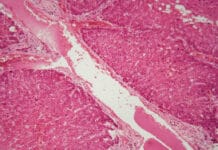Disclosure: This quiz is sponsored content from Cetylite as part of our sponsored partner program.
Test your AAP Guidelines knowledge with this quick quiz!
Thank you to Cetylite, the manufacturer of Cetacaine for sponsoring this quiz. For over 50 years, Cetacaine has been trusted by dentists and hygienists to deliver effective and rapid pain control where it is needed, and can help put nervous patients at ease. The unique formula combines three active ingredients to provide a rapid onset of 30 seconds with the benefit of a long duration of up to 60 minutes, when used as directed. Cetacaine is indicated for use on all accessible mucous membrane, except the eyes.
For dental procedures, such as SRP, Cetacaine Liquid can be comfortably dispensed into periodontal pockets for up to 60 minutes of needle-free pain control. The viscous liquid is easy to control using Cetylite’s single-use Delivery Syringes and Tips to comfortably apply Cetacaine Liquid drop by drop into periodontal pockets for SRP procedures, or by applying to surface of mucous membrane with a cotton swab or microbrush where pain control is needed. Each bottle includes a special luer-lock dispensing cap, used for filling syringes with just the amount of Cetacaine Liquid needed for treatment, reducing waste.
Cetacaine is not for injection. Cetacaine is contraindicated in patients who are hypersensitive to any of its ingredients. Cetacaine should not be used in patients with congenital or idiopathic methemoglobinemia.
Cetacaine is available in liquid, spray and gel. Rx Only.
Now, let's test your AAP Guidelines knowledge!
With the introduction of the new D4346 code in CDT 2017, dental professionals now have a treatment code to use when oral disease has led to moderate or severe inflammation in the absence of periodontitis. The Malamed Handbook of Local Anesthesia recommends the use of full-mouth injectable local anesthesia when completing D4346 and other full-mouth therapies.
With the introduction of the new D4346 code in CDT 2017, dental professionals now have a treatment code to use when oral disease has led to moderate or severe inflammation in the absence of periodontitis. According to the American Dental Association’s guidelines, this therapeutic code is a full-mouth procedure and is expected to be completed in a single day. When considering the use of local anesthesia during procedures, Malamed identifies various contraindications, adverse reactions, and patient-dependent factors such as anatomical variations, the presence of infection, and psychogenic factors. During full-mouth procedures like D4346, the use of full-mouth injectable local anesthesia is not ideal; instead, topical anesthetics such as Cetacaine are preferred.
Malamed, S.F. Handbook of Local Anesthesia. 5th ed. St. Louis, Mo: Mosby; 2004. Pharmacology of vasoconstrictors; pp. 41–54.
American Dental Association. ADA Guide to Reporting D4346. J Oral Microbiol. 2018;4: (1-11). https://www.ada.org/~/media/ADA/Publications/Files/D4346EducationGuidelines_V4_2018Jul06.pdf?la=en
When possible, the initial diagnosis of periodontitis should be based on radiographic bone loss.
False. According to the American Academy of Periodontology, when possible, the initial diagnosis of periodontitis should be based on clinical attachment loss (CAL). CAL is calculated by combining the periodontal probing depth with the distance from the cemento-enamel junction to the gingival margin. If CAL is not available, radiographic bone loss should be used. When diagnosing periodontitis, other factors should be taken into account such as tooth loss due to periodontitis, furcation involvement, tooth mobility, ridge defects, and more.
Tonetti, Greenwell, Kornman. J Periodontol 2018;89 (Supp 1): S159-S172. Retrieved from http://perio.org/sites/default/files/files/Staging%20and%20Grading%20Periodontitis.pdf
Which of the following categories are identified as the most up-to-date classifications for periodontitis?
Periodontitis classifications have been updated to align with emerging scientific evidence, according to the 2017 World Workshop on the Classification of Periodontal and Peri-implant Diseases and Conditions. The following three distinct categories are now accepted: necrotizing periodontitis, periodontitis as a manifestation of systemic disease, and periodontitis. These revised categories focus on the severity of disease and complexity of the disease management. The new guidelines also include a grading system that can be adapted as new evidence emerges.
Caton, J., Armitage, G., Berglundh, T., et al. A new classification scheme for periodontal and peri‐implant diseases and conditions – Introduction and key changes from the 1999 classification. J Periodontol. 2018; 89(Suppl 1): S1– S8. https://doi.org/10.1002/JPER.18-0157
Updated periodontal therapy guidelines confirm that a patient with gingivitis can revert to a state of health, though a patient with periodontitis must remain a periodontitis patient for life.
A committee at the 2017 World Workshop on the Classification of Periodontal and Peri-implant Diseases and Conditions was charged with updating the 1999 classification of periodontal diseases and conditions in order to reflect current understanding and evidence. While the updated classification system remained the same for certain classifications, the committee also modified and added new categories. For instance, the workshop concluded that though a patient with gingivitis can revert to a state of health, a patient with periodontitis must remain a periodontitis patient for life. New guidelines were also created to add specific verbiage for peri-implant diseases and conditions.
Caton, J., Armitage, G., Berglundh, T., et al. A new classification scheme for periodontal and peri‐implant diseases and conditions – Introduction and key changes from the 1999 classification. J Periodontol. 2018; 89( Suppl 1): S1– S8. https://doi.org/10.1002/JPER.18-0157
The intent of staging periodontitis is to classify the severity and extent of a patient’s disease. The intent of grading periodontitis is to identify the rate of progression, responsiveness to therapy, and potential impact on systemic health.
professionals to practice “staging and grading” of periodontitis. AAP defines staging and grading as the following:
· Staging intends to classify the severity and extent of a patient’s disease based on the measurable amount of destroyed and/or damaged tissue as a result of periodontitis and to assess the specific factors that may attribute to the complexity of long-term case management.
· Grading aims to indicate the rate of periodontitis progression, responsiveness to standard therapy, and potential impact on systemic health.
Tonetti, Greenwell, Kornman. J Periodontol 2018;89 (Supp 1): S159-S172. Retrieved from http://perio.org/sites/default/files/files/Staging%20and%20Grading%20Periodontitis.pdf








